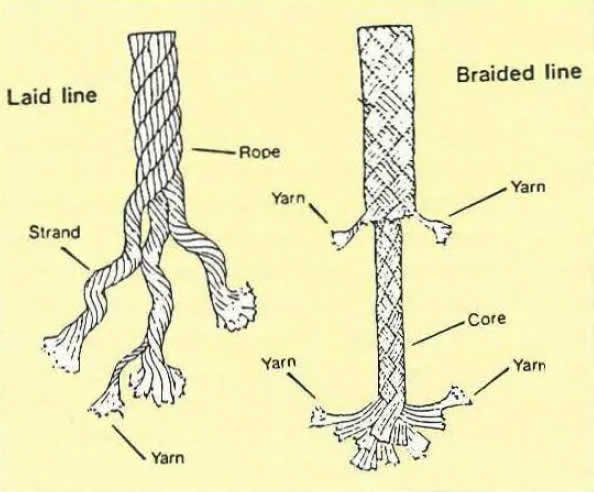Mooring & Docking Lines
Foundation Findings #18 - Circa 1993
Knowing the Ropes
In the aftermath of Hurricane Gloria, which damaged thousands of boats moored in New England, the Massachusetts Institute of Technology Sea Grant College conducted a study, the results of which challenged the conventional wisdom that nylon lines are the best choice for mooring lines. The study suggested that polyester may better withstand the forces of wind and storm surge, because it stretches less and would therefore be more resistant to chafe and internal failure. We were intrigued by this hypothesis, especially in light of our recent Foundation Findings (Report #16), in which we examined cleats as one component of a total mooring system. The MIT study prompted us to focus on a second mooring system component line.
In the laboratory at the University of Virginia School of Engineering, a series of tests were performed on nylon and polyester line (also known by its DuPont trade name, Dacron®) with the goal of either confirming or rejecting the MIT proposition. We tested four 3/8" ropes: nylon and polyester three strand laid rope, and nylon and polyester double-braid. These four ropes were chosen because their manufacturer's rated breaking strengths are very similar.

For the record, rope is cordage, the raw stuff. There's nothing nautical about it. Rope doesn't become line until it's aboard a boat and off the spool. Once you assign a specific function to a piece of line, you can give it a name that describes what it does - sheet, halyard, rode, painter, etc.
Test Procedures
The series of rope tests began with straight-pull, or tensile strength tests to confirm manufacturer's rated breaking strengths. The second test was designed to simulate the forces applied to a rope stretched over a rail or chock, a more realistic test than a simple straight pull. Each rope was bent at 45° over three pulleys, 1", 2" and 4" in diameter, in three separate tests. Force was applied until the rope broke. Strain gauges measured the force and transferred the readings to a chart recorder that graphed the force applied versus the distance the rope stretched. This second test was performed in two ways first, with the rope ends secured to the test apparatus with bowlines, as dock lines are frequently secured; and then using splices in each end, as recommended by the Cordage Institute, an industry organization that sets test standards.
Next, the ropes were subjected to cycling tests, repeated loading and relaxing of the rope in succession. This test was designed to simulate the effect on mooring and dock lines of repeated surges caused by wind and water.
Test Results
As a basis of comparison, we accepted the manufacturer's rated breaking strengths, shown in the chart on the next page. These figures are the result of tests performed to Cordage Institute standards. In our first test, ropes secured to the test apparatus with bowlines were bent around a pulley. The breaking point was invariably at the knot, where the rope is subject to compression forces as well as the tensile force of the pull. The breaks occurred at about one-half of the manufacturer's rated figure. When the test was repeated with the lines secured by splices or by wrapping around a roller, breaking strengths were again reduced by about 50%, but the breaks consistently occurred in the portion of the line passing over the pulley. In all of these tests, the braided nylon proved strongest, retaining a greater percentage (64.6° on average) of its rated breaking strength than the other three types.
Theoretically, the larger the pulley around which the rope is pulled, the greater load each rope tolerates before breaking. This appears to be the result of compression- a greater radius or angle of bend in the rope lowers the force of compression on the line, which, in turn, reduces the amount of internal abrasion. However, our findings do not fully bear this out, because the difference between a 1' and a 4" pulley is not significant, and because our sample size of six lines for each test was relatively small. We believe the radius of the bend has a direct bearing on the effectiveness of certain types of chafe gear (see Conclusions).
The tensile strength tests produced two kinds of failures: ruptures caused by elongation and fatigue in the rope; and abrasion, both internal and external. With the laid three-strand ropes, one strand always failed first, followed by the others. In stranded ropes, the load is distributed unevenly among the strands because they are not all precisely the same length, and because friction between strands is not uniform.
With double-braided rope, the core failed by stretching and thinning just before breaking. The core became hot at the breaking point (but nowhere else along the rope), and the broken rope was hot to the touch. The nylon double-braid melted in several tests, leaving a length of about 10" where the center core had melted.
The three-strand ropes, both nylon and polyester, stretched twice as much (100-140%) as the double braided ropes (50-70%) before breaking when the ropes were not pre-stretched. When pre-stretched before testing, as recommended by the Cordage Institute, nylon showed greater elongation (120-130%) than polyester (110-120%). Pre-stretching allows the rope fibers and construction to "set" or stabilize, especially in a splice, and gives much more consistent results.
Cycling testing was less conclusive, for two reasons. First, there is considerable variation in breaking strengths when ropes are bent around a pulley. Second, a rope can be cycled countless times at less than 90% of its actual (not rated) breaking strength. Above 90%, the rope breaks in 10 to 100 cycles. As in the earlier pull tests, the ropes broke where they passed around the roller. Some wear was evident on the outer covering of the double-braid, but this was not the cause of the failures. Failures were caused by repeated internal stresses creating fatigue in the rope.

